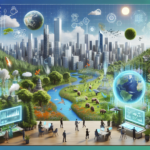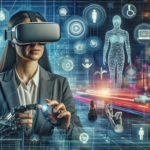Exploring the Apple Unity Acquisition: A Game Changer for XR Content Creation
The buzz around the potential Apple Unity Acquisition is captivating the tech and gaming worlds. This merger could significantly transform the landscape of Extended Reality (XR) content creation. In this post, we will explore what this acquisition could mean for the future of XR and the implications it may carry for developers and industries alike.
The Current XR Development Environment
Unity already stands tall as a leader in XR development, powering a multitude of platforms such as Apple’s visionOS, Meta Quest, PlayStation®VR2, and heads supported by OpenXR. Its powerful tools like AR Foundation, Universal Render Pipeline, and the XR Interaction Toolkit allow developers to craft immersive experiences, blending digital content with real-world settings, thus paving the way for a more engaging user experience.
Apple’s Ambitious Vision in Spatial Computing
Apple is making waves in the realm of spatial computing with its introduction of the Apple Vision Pro and visionOS. The company aims to redefine our interactions with digital content. Collaborating with Unity to harness Unity’s innovative PolySpatial technology could enable Apple to craft next-gen spatial experiences. This partnership would empower developers to transition existing VR experiences, craft fresh immersive worlds, and operate multiple applications in passthrough modes.
Benefits of the Apple Unity Acquisition
If Apple were to pursue the acquisition of Unity, several exciting benefits could emerge:
Seamless Integration and Optimization
This acquisition would likely facilitate deeper integration between Unity’s tools and Apple’s ecosystem. Such synergies could lead to improved performance and exclusive features for XR content developed for Apple products. Developers would experience enhanced quality and efficiency through streamlined processes combined with seamless interactions between Unity’s authoring tools and Apple’s hardware.
Robust Resources and Enhanced Support
Apple’s vast resources could provide Unity with the necessary support for further innovation. This backing may include improved developer resources, extensive training programs, and access to Apple’s impressive network within the industry. Ultimately, this would create a healthier ecosystem for XR content creation.
Strengthened Competitive Position
Acquiring Unity would strengthen Apple’s competitive stance in the XR market. With historical friction between Apple and Unreal Engine, bringing Unity under its wing could give Apple a formidable edge against competitors such as Meta and Epic Games. This acquisition would solidify Apple’s leadership in spatial computing and present a robust alternative to Unreal Engine.
Industry Impacts of the Acquisition
The repercussions of an Apple Unity Acquisition would span various sectors. Unity’s offerings are already integral in industries like automotive, energy, manufacturing, retail, and engineering. Apple’s support could accelerate the adoption of XR technologies, fostering innovative applications in areas such as training, design, and customer engagement.
Enhancing Apple’s visionOS with Unity’s Tools
Unity’s tools have already played a crucial role in developing spatial experiences on visionOS. Here’s how they would further augment the platform:
AR Foundation and XR Interaction Toolkit
These essential tools allow developers to merge digital content with physical surroundings, enabling sophisticated interactions like hand gestures and object tracking. An acquisition could lead to further refinement and optimization, making it simpler for developers to craft engaging and interactive experiences.
Universal Render Pipeline (URP)
The Universal Render Pipeline is vital for delivering stunning graphics while ensuring smooth frame rates. With Apple investing in Unity, URP would likely stay at the forefront of XR development on Apple devices, equipping developers with the capabilities to produce striking and immersive experiences without sacrificing performance.
PolySpatial Technology
Unity’s PolySpatial technology seamlessly integrates with visionOS, empowering developers to forge the next generation of spatial experiences. Under Apple’s ownership, this technology could see deeper development and integration, facilitating even more sophisticated and engaging XR applications.
Case Studies of Unity and Apple Collaborations
Several notable projects illustrate the potential collaboration between Unity and Apple:
LEGO® Builder’s Journey
Light Brick Studio successfully adapted *LEGO® Builder’s Journey* for Apple Vision Pro, leveraging Unity’s tools. This project tackled significant rendering and optimization challenges, ultimately showcasing Unity’s capability to deliver exceptional XR experiences.
Don Julio’s Interactive App
Trigger XR developed an immersive application for Don Julio on the Apple Vision Pro, highlighting the tequila brand’s heritage through engaging interactive experiences. This project exemplifies the effectiveness of Unity’s tools in creating compelling XR content tailored to specific brands.
Steps for Developers in XR Evolution
For developers keen to excel in the rapidly evolving XR landscape, consider these preparatory steps:
- Familiarize with Unity’s XR Tools: Dive into the features of AR Foundation, XR Interaction Toolkit, and Universal Render Pipeline to unleash the potential of immersive experiences.
- Update Your Projects: Ensure your projects align with the latest Unity versions and are optimized for visionOS.
- Utilize visionOS Support: Take advantage of Unity’s visionOS Support for next-gen immersive experiences.
- Stay Informed: Attend Unity’s WWDC sessions and other educational resources to remain up to date with the newest developments in spatial computing.
By taking these proactive steps, developers can place themselves at the forefront of XR content creation, ready to harness the full capabilities of any upcoming collaboration between Apple and Unity.




0 Comments